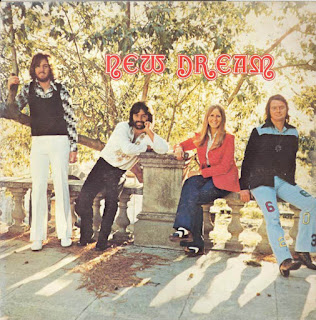Translate
Saturday, 16 January 2016
Campact and The Dream - 1968 - Something Easy-Mercy Mercy Mercy
Campact
Something Easy/Michael
The Dream
Who Could Be Lovin' You/Mercy Mercy Mercy
Cam-Pact were formed in Melbourne in April 1967 with a line up of Mark Barnes on bass guitar (ex-Moppa Blues, Roadrunners, Delta Set); Keith Glass on vocals and guitar (Rising Sons, Eighteenth Century Quartet); John Pugh on guitar, vocals and autoharp (Roadrunners, Delta Set, Eighteenth Century Quartet); Chris Stockley on guitar (Roadrunners, Delta Set); and Bob Lloyd (aka Bob Tregilgus) on drums. Originally named The Camp Act but, as that was "too outrageous", they soon changed to Cam-Pact. Initially they performed soul music in the Stax Records and Tamla-Motown mould. By 1968 Greg Cook, on organ and guitar, had replaced Pugh; and Trevor Courtney had replaced Lloyd on drums.
In March 1968 they issued their debut single, "Something Easy", on Festival Records followed by a four-track extended play of the same name. The track was written by Glass. Their second single, "Drawing Room", appeared in May and was also written by Glass. It was followed by a third single, "Good Good Feelin'", in September, which was co-written by Cook and Courtney. Late that year Barnes left and Glass took up bass guitar. The group issued a fourth single, "Potion of Love", in June 1969. Australian musicologist, Ian McFarlane, described these singles as "fine examples of late 1960s psychedelic pop".
A balcony in Carlton, Melbourne (circa 1967)
Left to right - Mark Barnes, Chris Stockley
Keith Glass, John Pugh & Robert Lloyd
By mid-1969 Glass had left to join the cast of Hair and Stockley left to join Axiom, and they were replaced by Chris Löfvén on bass guitar and Russell Smith on guitar, respectively. The group issued a second EP, Cam-Pact / Pastoral Symphony, with two tracks by Cam-Pact and two by label mates, Pastoral Symphony, which were a studio ensemble. Soon after Cook was replaced in Cam-Pact by Bill Blissett on organ and vocals. In September that year they released another single, "Zoom Zoom Zoom", and an EP of that name.
Outside The Stokehouse at a beach stomp
L to R: Trevor Courtney, Keith Glass, Chris Stockley & Greg Cook
Early in 1970 Ray Arnott (ex-Chelsea Set, Browns) replaced Courtney on drums and Cliff Edwards replaced Löfvén on bass guitar. They toured to Sydney with Matt Taylor guesting on lead vocals (ex-Wild Cherries). A three-piece line up of Arnott, Edwards and Smith continued until March 1970 before the trio formed Company Caine with Gulliver Smith on lead vocals and Jeremy Noone on saxophone.
The Dream formed in 1967 when singer Alex Opitz and keyboard player Jenny Johnson, both from The Changing Times, joined forces with members of another Melbourne discotheque band, The Final Four. In January 1968 they appeared as a support on the infamous Who-Small Faces "Big Show" tour, and in June Peter Nicoll left the group, to be replaced by Brian Holloway. Holloway left later in the year to join the remaining members of Somebody's Image, which became The Image after the departure of lead singer Russell Morris, and he subsequently played in Ronnie Charles' shortlived supergroup Captain Australia & The Honky Tonk.
The Dream did not make any known commercial recordings. In April 1969 the group was relaunched as The New Dream, and their style changed to exploit the current "bubblegum pop" trend; Glenn A Baker has written that their agency was grooming the band to take over from Zoot. They signed with Festival and issued their first two singles during the year, "Yours Until Tomorrow" (April) and Catching Up On Fun" (July), which made the Melbourne charts.
Their first national success came with their third single, "Groupie", one of a string of successful formula bubblegum songs written by Buzz Cason, the American who also penned "Hayride" (the hit debut for The Flying Circus) and "Everlasting Love", which was also a big hit for The Town Criers. "Groupie" became a national hit, reaching #28 in March 1970, but the time the single came out the lineup had changed to Kadell, Johnson, John Bois (bass) and Peter Reed (drums).
Regular dance circuit bookings and TV appearances on Happenning '70 helped the band to build up popularity with teen audiences, and their next three singles all made the charts. "Soft Delights" (May 1971) only just missed out on a Top 20 placing, and although "Candy Love" (Sep. 1971) only scraped into the lower reaches of the Top 100, "Turned 21" (March 1972) fared much better, reaching #31. In January 1972 John Bois left to join Country Radio and he was replaced by Graham Jones (also ex Iguana, Captain Australia & The Honky Tonk).
This new lineup recorded their only LP and their last two singles, a cover of T-Rex's "Ride A White Swan" (Dec. 1972) and "Girl I'm Gonna Get You" (Feb. 1973). Their self-titled LP, produced by Brian Cadd, featured what Ian McFarlane describes as "...a gloriously campy mix of the band's bubblegum hits, easy listening pop fluff replete with sweet harmonies and schmaltz strings, plus a cover of joni Mitchell's 'Cheslea Morning' ...".
The group broke up at the end of 1972; with Kadell embarked on a solo career, and Peter Reed joined Gary Young's Hot Dog (he later played with Pantha and Bandicoot, the group that featured Mick Fettes (Madder Lake) and Shane Bourne). Kadell and Johnson revived the New Dream name for two singles released during 1974. The first, "I Can't Stop Dancing (In The Dark)" (July) was written by Andy Fairweather-Low and produced by Steve Groves (ex Tin Tin); the second the oddly-titled "Schlick Schlak Boom Boom" was produced by Buddy England. Neither single made any impression, and the group faded from view.
Subscribe to:
Post Comments (Atom)






Great Post! Thanks
ReplyDelete